Grill Master Secrets: Elevate Your Grilling Game
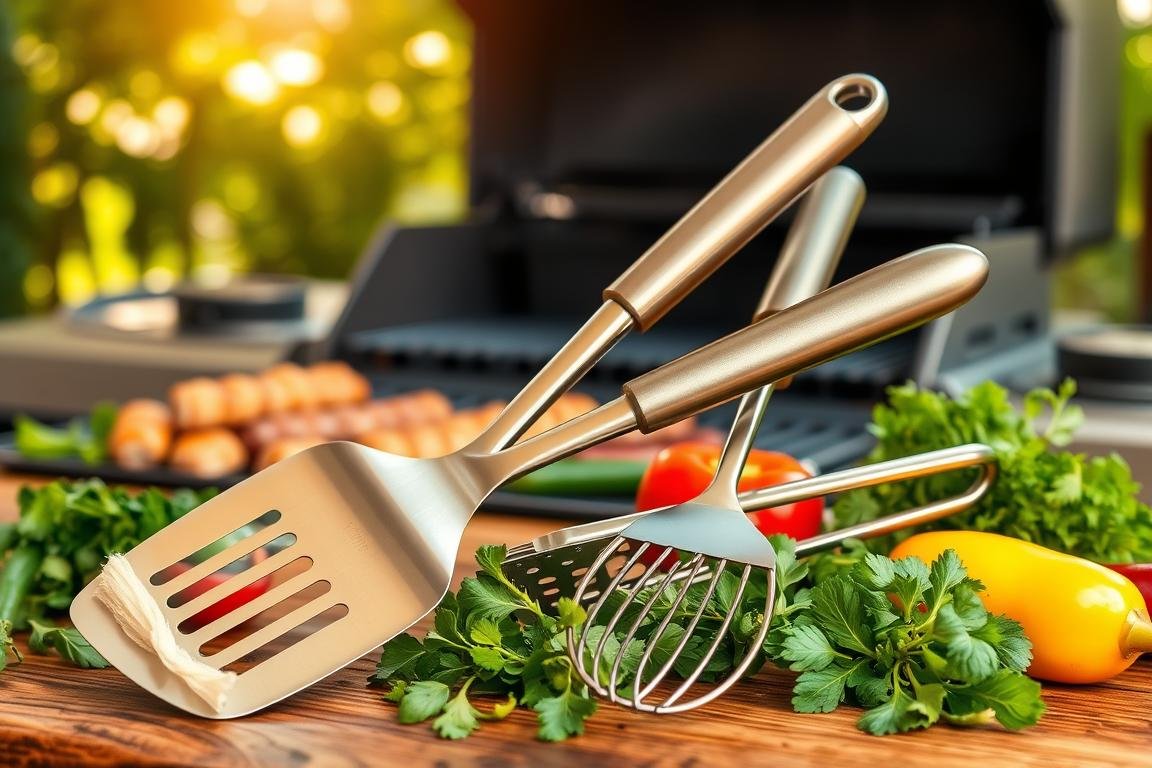
Ever wondered why some grilled dishes are so famous? It’s not just about the recipes. It’s also about mastering grilling itself. To really elevate your grilling game and be the top grill master, learn the secrets. Dive into the world of barbecue tips and outdoor cooking techniques. These secrets can turn any cookout into a showcase of culinary brilliance.
So, where should you start? This guide will help you. You’ll learn to pick and use vital grilling tools. Knowing how to handle tongs and use a digital thermometer is key. With heat-resistant gloves and a reliable grill brush, safety and cleanliness are also easy to manage. Welcome to where your grilling passion and our know-how meet. Together, we’ll create amazing outdoor feasts.
Key Takeaways
- Discover how pre-injecting marinade enhances flavors and ensures a juicy feast.
- Learn the importance of thermometers for health and taste precision across different meats.
- Realize how heat-resistant gloves and the right cleaning tools can redefine grill safety and maintenance.
- Find out why specialized tools like rotisserie spits, cast-iron pans, woks, and smoker boxes are game-changers.
- Uncover the tangible benefits of recording your grilling journey with Butcher BBQ’s recipe app or a traditional notebook for consistency.
- Gain insights into how note-taking can lead to masterful troubleshooting and technique improvement in grilling.
- Explore local hardware stores to physically examine and choose the best grilling tools for your arsenal.
Understanding the Basics of Grilling
Starting your grilling journey requires learning the basics. This includes choosing the right grill and getting the right tools. You also need to follow safety rules to cook safely and have fun. These tips are useful for both beginners and experts in grilling.
Types of Grills: Charcoal vs. Gas vs. Electric
Choosing a grill impacts your food’s flavor and how you control the heat. Charcoal grills add a smoky taste but take longer to get ready. Gas grills heat up quickly and are easy to use, great for daily meals. Electric grills are good for small spaces or places where you can’t have open flames.
Essential Grilling Tools You Need
Having the right tools makes grilling easier and better. A good set includes tongs, a spatula, a basting brush, and a marinade injector. To grill safely and accurately, use heat-resistant gloves and a good thermometer. These help you keep the right temperature without guessing.
Safety Tips for Grilling
Keeping safety in mind is important for accident-free grilling and perfectly cooked food. Keep your grill clean and on a flat surface to stop flare-ups and tipping. It’s vital to cook meat to the right temperatures—165°F for chicken and 145°F for beef. Also, never walk away from a lit grill.
Knowing the basics of grilling helps you cook safely and make tasty dishes. Learn about different grills, choose the right tools, and follow safety steps. Starting with these basics helps you grill successfully and safely. Remember, good grilling begins with preparation and knowledge.
Choosing the Right Ingredients for Your Grill
Starting your grilling quest means picking the best ingredients. Combine top meat cuts with bright veggies. Add your own twist with special marinades. This turns a basic meal into a feast.
Selecting the Best Cuts of Meat
For grilling, meat quality is key. Choose top-notch cuts like ribeye, chicken thighs, and pork loin. These ensure your meal is soft and juicy. Smoker fans should try brisket or pork shoulders. Their fat melts perfectly, adding rich smokey tastes.
The Importance of Fresh Veggies
Fresh veggies are crucial for grilling. Bell peppers, asparagus, and corn add color and taste. They soak up the smoke but stay crisp. Veggies make dishes complete and should stand out beside your meats.
Marinades and Seasonings to Enhance Flavor
Marinades vary from simple olive oil and herbs to complex spice mixes. Marinate early—ideally overnight. This makes the meat flavorful, tender, and juicy. A good marinade boosts both taste and texture.
| Ingredient | Recommendation for Marinade | Recommended Grilling Method |
|---|---|---|
| Chicken | Lemon herb garlic | Direct heat |
| Beef Steak | Soy sauce and brown sugar | Direct heat for searing, then indirect |
| Vegetables | Balsamic vinegar and black pepper | Indirect heat |
Your grill can be the star of food experiments, with the right meats, veggies, and marinades. Fire up your grill and enjoy the burst of flavors.
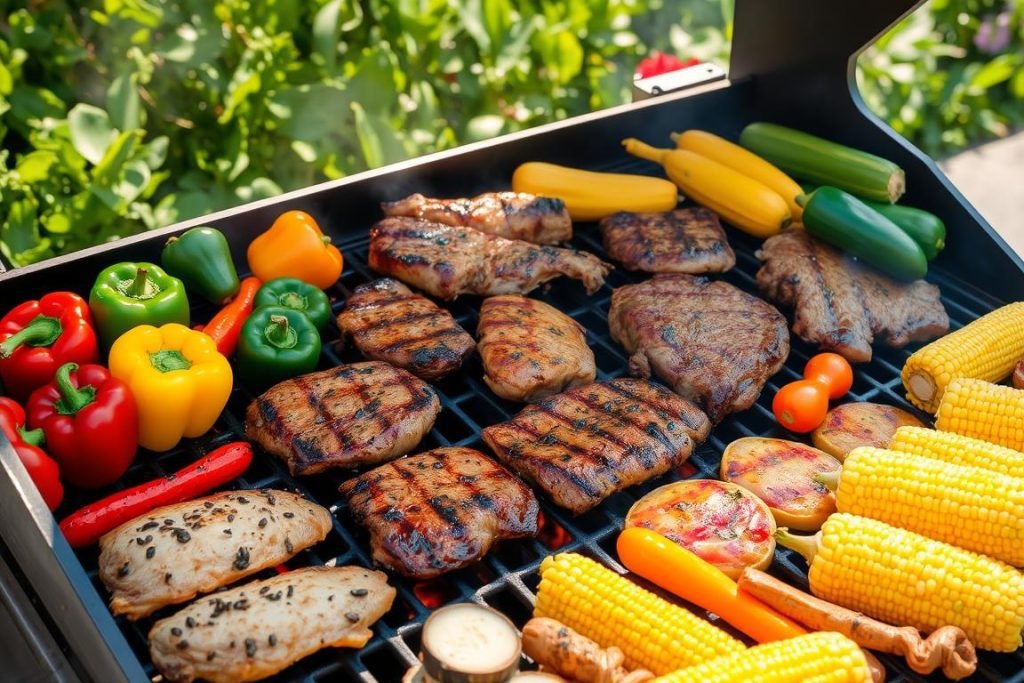
Mastering Temperature Control
The key to great grilling is controlling the heat. Knowing how to manage your grill’s heat means your food will taste amazing. It’s about cooking it just right and making it flavorful. It helps to know some outdoor cooking techniques and to use good tools.
The Importance of Preheating
Don’t skip preheating your grill. It’s key for searing meats and keeping them juicy. By heating your grill right, you cook faster and make better food.
Gauging Temperature: Thermometers vs. Hand Tests
The hand test is quick but not precise. Using thermometers helps you know the exact grill and food temperature. This is a smart grilling hack to cook your meals just right.
Techniques for Cooking at Different Temperatures
It’s important to cook at different heat levels. Zone cooking makes different heat areas on your grill. This lets you cook many things at once, like searing or slow roasting.

| Technique | Benefit | Recommended for |
|---|---|---|
| Two-zone fire setup | Different heat levels for various cooking needs | Grilling meats and vegetables together |
| Consistent vent management | Maintain stable grill temperatures | Long smoking sessions |
| Regular use of thermometer | Ensure food reaches safe internal temperatures | All types of grilled dishes |
| Strategic charcoal arrangement | Even heat distribution | Searing and full grill usage |
Using these outdoor cooking techniques and grilling hacks makes your grilling better. You’ll make perfect meals every time.
Techniques for Perfect Grilling
Grilling is more than just starting the barbecue. You will learn key outdoor cooking techniques and grilling hacks. These tips make sure your meals always wow your guests. We’ll talk about managing heat, getting the timing right, and handling food.
Direct vs. Indirect Heat: When to Use Each
It’s important to know about direct and indirect heat for grilling. Use direct heat for quick-cooking items like thin meat, seafood, and veggies. They get a tasty char this way. Indirect heat is better for big cuts like whole chickens or roasts. It cooks them slow and even without burning.
The Flip: Best Practices for Turning Food
Flipping food on the grill seems easy, but there’s a right way to do it. Use tools like long tongs or a spatula. This keeps the juices in the food. Steaks may need just one flip for a good crust. But burgers or veggies might need more flips to cook right. Watch them closely to avoid burning.
Cooking Times: How to Avoid Overcooking
How long you grill is key for taste and texture. Overcooking can spoil a meal. Different foods need different cooking times. For example, thin steaks cook fast, but thick cuts like brisket take longer. Use a meat thermometer to check if food is done. This way, everything you cook will turn out just right.

Keep practicing these outdoor cooking techniques. Adjust your methods based on the food and grill. Try new settings, tools, and times to discover what works best for you. Soon, these grilling hacks will feel natural. Your grilling will impress everyone who tries it.
Elevating Flavor with Smoke
Grilling is more than just fire skills. It’s about sophisticated smoking and rich flavors. Smoking is an art. It involves knowing how each wood and seasoning changes the taste.
Wood Choices for Different Meats
Choosing the right wood is key for the right smoke taste. Hardwoods like hickory and mesquite are great for beef and pork. They offer a strong flavor. Fruitwoods like apple give a lighter, sweeter taste for poultry and fish. Oak is good for many meats because of its classic smoky taste.
Smoking Techniques: Hot vs. Cold Smoking
There are hot and cold smoking techniques. Hot smoking flavors and cooks meat at 200-225°F. It’s good for most meats. Cold smoking is for foods like cheese and some fish. It adds flavor without cooking the food.
Experimenting with Flavor Combinations
Smoking is also about mixing woods and seasonings. Trying new combinations is important. You can smoke the seasonings or add them to marinades. Think about apple wood with cumin, or hickory with smoked paprika and sea salt.
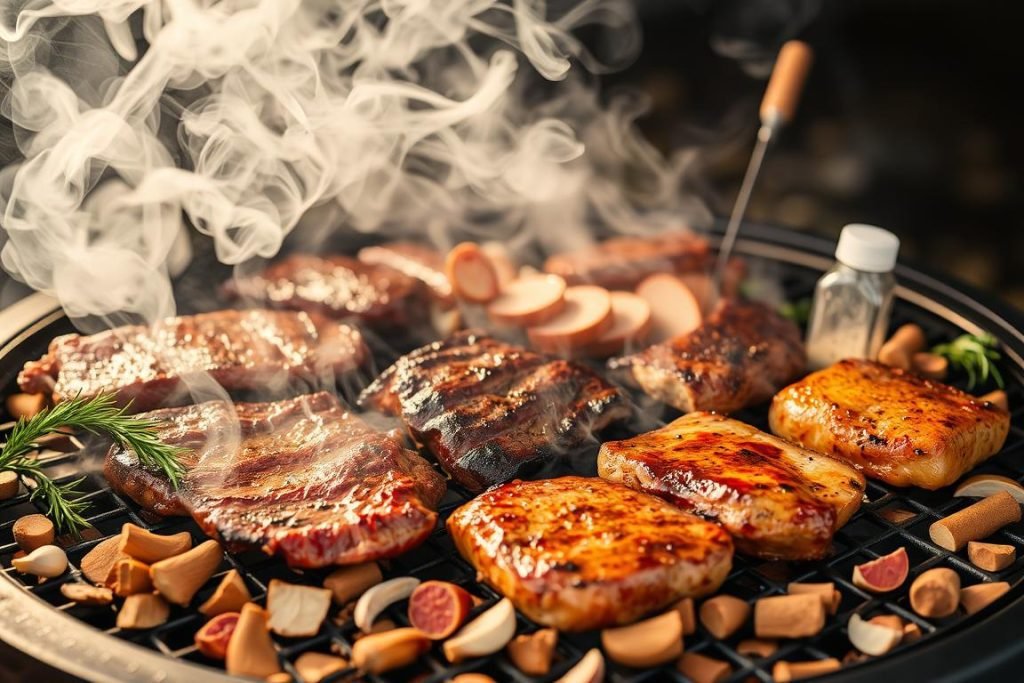
| Wood Type | Flavor Profile | Ideal Meats |
|---|---|---|
| Hickory | Bold | Beef, Pork |
| Mesquite | Slightly Sweet | Beef |
| Apple | Mild & Fruity | Chicken, Fish |
| Oak | Classic Smokiness | Beef, Pork, Poultry |
Mastering smoking turns your grill into a place for creative cooking. It’s not all about the heat. It’s about the smoke flavors that wrap around each dish. They bring their own special taste stories.
The Art of Grilling Vegetables
Mastering vegetable grilling can turn your barbecue into a colorful feast. Summer is the best time for smoky flavors. Learn to grill veggies like bell peppers and asparagus. They will amaze anyone.
Grilling Techniques for Different Vegetables
Each veggie needs a special way to grill. Firm ones like bell peppers do well with direct heat. Soft ones like mushrooms are better with indirect heat to stop charring. Make sure to preheat your grill and cut vegetables the right way.
Grill vegetables for 4 to 5 minutes on each side. This makes them cook evenly.
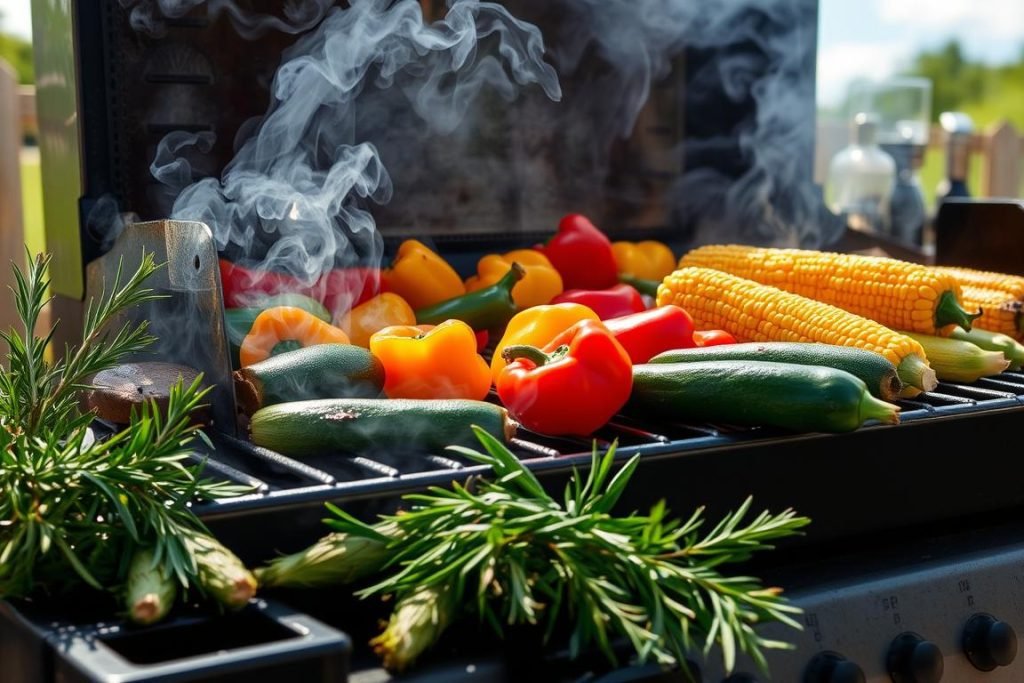
Seasoning Ideas to Enhance Grilled Veggies
Seasoning makes grilled vegetables taste even better. Try marinating them in olive oil, garlic, and spices. This adds great flavors.
Cumin and cinnamon give veggies an extra tasty twist. It makes them really stand out.
Tips for Preventing Sticking and Burning
No one likes veggies that stick or burn. Always oil your grill grates well. You can use an onion to help oil the grates naturally.
Turn the veggies often and carefully. This stops them from sticking or burning. Now you’ll have perfect grilled vegetables.
- Preheat your grill to stop veggies from sticking.
- Choose the right grilling method for the vegetable.
- Season well to enhance the flavor of your veggies.
Trying new seasonings and grilling ways brings out new tastes. These tips help make your grilled veggies crunchy and smoky. They’ll be loved at any meal.
Sauces and Rubs: Adding a Unique Touch
Grilling is an art where sauces and rubs play a big role. The right sauce or rub can take your dish from good to great. Whether you love bold BBQ flavors or fancy gourmet tastes, try different sauces to improve your grilling.
Classic BBQ Sauces vs. Gourmet Options
Choosing between classic BBQ sauces and gourmet ones can be fun. Classic sauces mix tomato, vinegar, sugar, and spices for a tangy taste. Gourmet options might have things like bourbon or wild berries for a fancy twist. Head Country BBQ sauces & Rubs offer flavors from North Carolina to Texas, so everyone can find something they like.
Creating Your Own Signature Rub
Making your own rub lets you add a personal touch to grilling. Start with basics like salt, pepper, garlic, and onion. Then, get creative with things like brown sugar or coffee. Butcher BBQ offers tips for rubs that make great crusts on meat. Their products like an All-Purpose Rub and a Brisket Rub show how special mixes can bring out the best in your meat.
When to Apply Sauces During Cooking
Knowing when to put BBQ sauce on is important to avoid burnt food. Add sauces with sugar in the last few minutes to keep them from burning. This way, they caramelize perfectly and make your dish taste amazing.
There are many sauce and rub options out there, even gluten-free ones. Companies like Big Poppa Smokers provide many choices. Whether you’re using a classic BBQ sauce or your own rub, these additions make your grilling stand out.
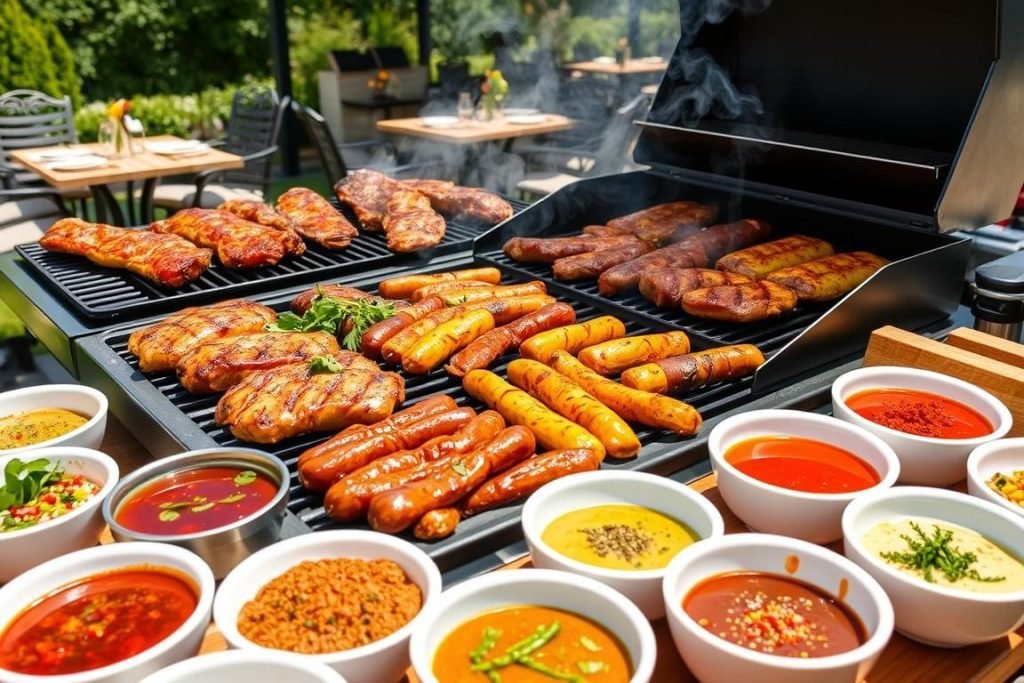
The Importance of Resting Your Meat
Grilling is more than just working with flames. It’s crucial to rest your meat after cooking. Resting boosts flavor and tenderness. It makes every bite juicy.
Resting lets the meat’s fibers soak up juices again. Otherwise, these juices are lost if the meat is cut too soon.
Why Resting Matters for Flavor and Tenderness
Resting means giving meat time to soak up juices. This makes it tasty and tender. Steaks or chicken need this for the best texture.
Best Practices for Letting Meat Rest
Use foil to loosely cover the meat off the grill. This keeps it warm without more cooking. Rest time should be 5-10 minutes per pound.
Right resting means moist and tender meat.
How Long to Rest Different Types of Meat
| Type of Meat | Resting Time | Internal Temp |
|---|---|---|
| Chicken | 5-10 mins | 165°F |
| Beef Steaks/Roasts | 5-10 mins | 145°F |
| Game Meats (e.g., Venison) | 5-10 mins | 56-70°C |
Knowing how to rest meat makes grilled dishes better. It keeps them flavorful and tender. Good dishes become great with patience.
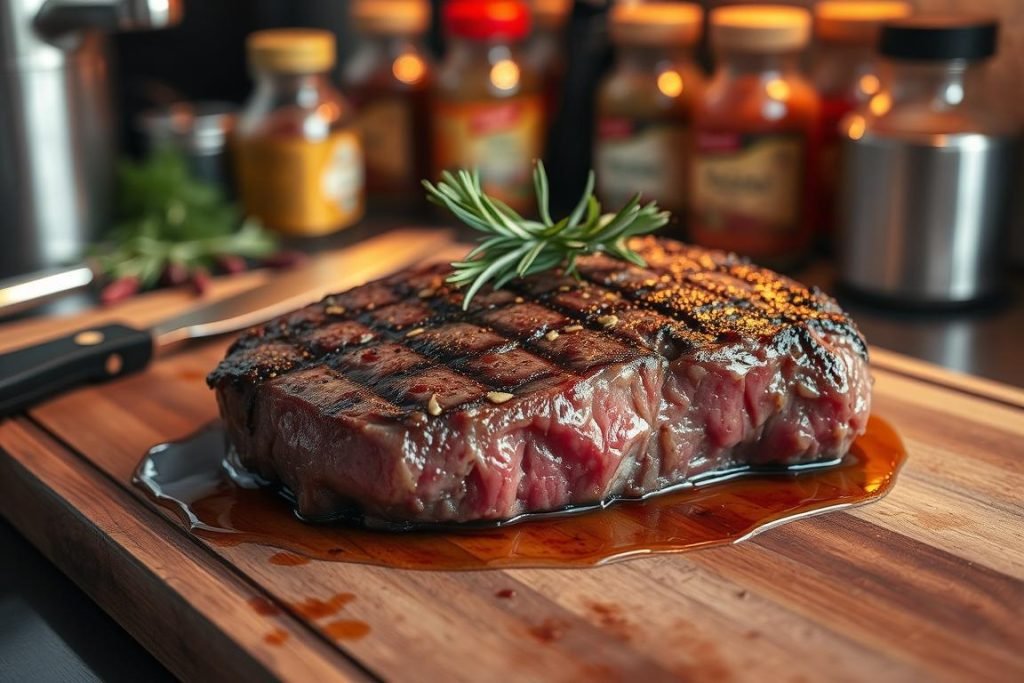
Troubleshooting Common Grilling Issues
Grilling is an art with its own ups and downs. Knowing how to fix common problems makes grilling safer. It also keeps your grill ready for your next cookout.
What to Do When Your Grill Won’t Heat
It’s no fun when the grill won’t start. First, check if you have enough fuel, like propane or charcoal. With gas grills, the burners must be clean of blockages. If it still won’t work, the ignition might be the issue. Fixing it can get your grilling back on track fast.
Fixing Overcooked or Undercooked Food
If your food is too cooked, don’t worry. You can still use it in dishes like tacos or salads. If it’s not cooked enough, just grill it more. Use a lower heat this time. Always watch the temperature closely to avoid this problem again.
Managing Flare-Ups: Prevention and Solutions
Flare-ups can be scary. To stop them, always clean your grill grates. Also, avoid putting too much fatty food on at once. If flames do pop up, move the food away. You can also lower the heat. A spray bottle of water can help without harming the food.

Learning these tips helps your grill last longer and keeps grilling fun and safe. Keep your grill in good shape and follow safety tips. That way, you’ll beat most grilling troubles.
Grill Maintenance for Longevity
Keeping your grill in good shape improves how it works and makes it last longer. This means you can enjoy many seasons of great barbecues. It’s important for all grillers to know how to take care of their grill.
Cleaning Your Grill After Each Use
Cleaning your grill every time you use it is key. Scrub the grates when they’re still warm. This helps get rid of grease and bits of food easily. Use a grill brush or special tools made for your grill. This protects the surface you cook on. Clean often because:
- It stops flavors from mixing and keeps your food safe.
- It keeps harmful stuff from building up on the grill.
- Your grill will cook more evenly next time.
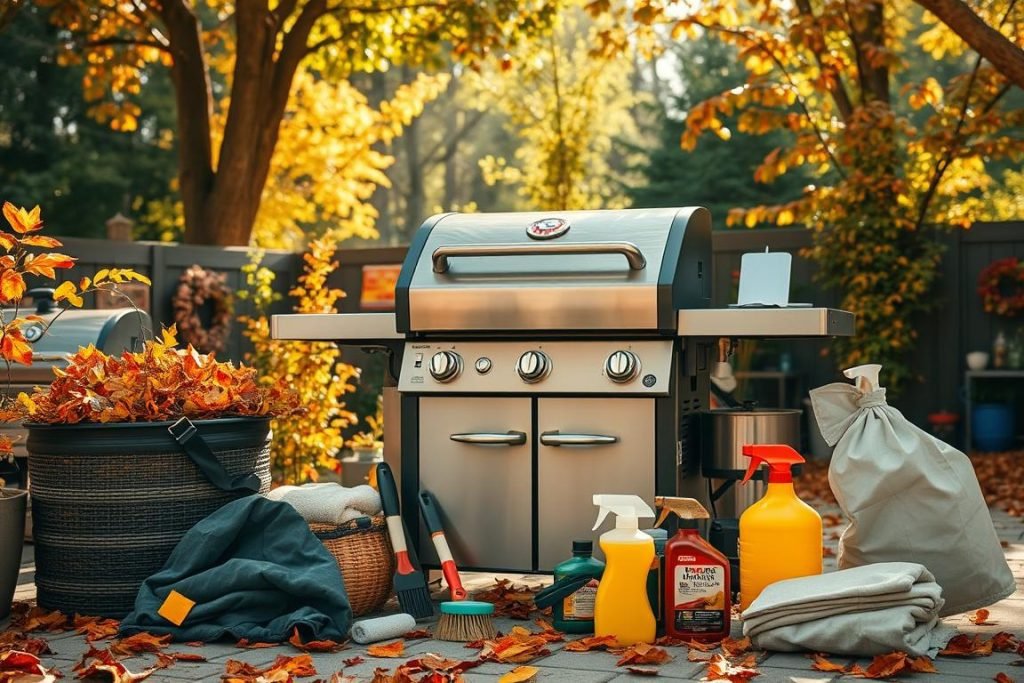
Seasonal Maintenance Tips
As the weather changes, your grill care should too. Here’s a checklist to keep your grill great:
- Check your grill for any damage at the beginning and end of the grilling season.
- Give it a good clean inside and out to get rid of any dirt.
- Look at all the connections and gas lines (for gas grills) to make sure there are no leaks.
- Replace any parts that are too worn out or damaged.
- Cover your grill to protect it from bad weather.
Doing these things every season helps keep your grill safe and ready to use any time.
Recognizing When It’s Time to Replace Your Grill
Sometimes, no matter how well you take care of it, your grill will need to be replaced. Here are signs you might need a new grill:
- Heating is uneven or there are cold spots after you’ve cleaned and maintained it well.
- There’s rust or damage that can’t be fixed, especially on important parts like where you cook or connect gas.
- If you’re always fixing it and those repairs cost more than getting a new grill.
Regular care and paying attention to your grill’s condition makes grilling better. It ensures every barbecue is fun and delicious.
Advanced Grilling Techniques to Impress
If you love grilling, there are cool ways to get better at it. Whether you use a gas grill or charcoal, you can always improve. Upgrading your skills makes cooking outside more fun.
Sous Vide Grilling for Perfectly Cooked Meat
Start sous vide grilling by cooking meat in a water bath. Then sear it on the grill. It makes meat tender inside and crispy outside. This way, beef and chicken cook just right.
Plank Grilling: Enhancing Flavor with Wood
Cooking on wood planks over the grill adds a smoky taste. You can use different woods like cedar or hickory. Soak the plank before grilling to avoid burning and add flavor.
Smoking on the Grill: A Step-by-Step Guide
Turning your grill into a smoker adds a deep smoky flavor. Use a smoker box or wood chips next to your meat. This method is great for enhancing meat’s texture and taste.
A good meat thermometer helps keep the right temperature. Joining grilling groups teaches you more tricks. They share tips and recipes. These advanced techniques will wow your friends at your next barbecue.